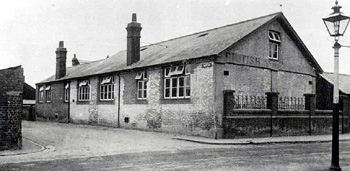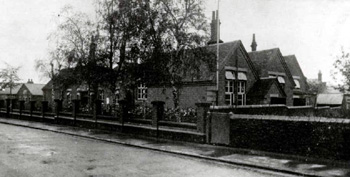Beaudesert Infants School Leighton Buzzard

Beaudesert Council Infants' School in 1913 [Z50/72/21]
1893 to 1946
In March 1893 a School Board was formed in Leighton Buzzard which took over the running of the British Schools, henceforth known as Board Schools. By this time there was need for a second infants' school in the town to augment the school in Bassett Road which had been open since 1839. It was decided to use the 1813 built British Boys' School premises in Beaudesert for the infants which, after enlargement and alteration could accommodate 300. This school lay on the corner of Beaudesert and East Street. The new Board Boys' School, built in the same year as the reorganisation could accommodate 270. It lay on an adjacent plot on the east side of Beaudesert extending as far down as opposite the junction with Lammas Walk.
The Education Act of 1902 abolished School Boards, replacing them with a Local Education Authority which, for Bedfordshire, was Bedfordshire County Council. Thus board schools became known as council schools. Bedfordshire & Luton Archives & Records Service has a scrapbook of cuttings of visits made to most Bedfordshire Schools by School Inspectors for a period from just before the First World War through the inter-war years [E/IN1/1].

Beaudesert school buildings in 1901 in red
The first inspection of the school in the volume came in 1911, when average attendance was 235. The inspector stated: "This School has had a very troubled history during the past two years, Epidemic sickness, building troubles, changes of Staff and the loss of an excellent Head Mistress have had their inevitable effect, but not to so great an extent as might have been reasonably expected, thanks to the loyalty and hard work of the Staff. Under the new Head Mistress and with, as is to be hoped, a cessation of troubles, there is every reason to believe that the old efficiency will be fully restored".
Two years later the inspector reported: "Satisfactory progress is being made and it is confidently anticipated that the methods of instruction now adopted will have the effect of increasing the interest in the work and of considerably raising its educational value". The next inspection was in July 1914, just before the outbreak of the First World War: "This school has, as was anticipated in the last report, steadily improved and more than recovered the former high efficiency. Its condition now is completely satisfactory and highly creditable to the Head Teacher and her staff".
The first inspection reported after World War One came in 1921, when average attendance was 178: "This School is admittedly one of great difficulty. Many of the children enter rather old, and several come from poor homes" However: "There is much that is very pleasant in the School, and the Head Teacher and the regular members of the staff are working well; but it is felt that, at present, the weaker sections are not given sufficient attention or stimulus. Probably a reconsideration of methods, in order that more individual teaching on the lines adopted in so many of our better Schools might be attempted, would also help to bring about improvement".
Three years later average attendance was just 133 and the lower numbers were reflected in a better report. The report of 1928, average attendance 158, noted many changes: "The four Teachers in this School have all been appointed in the last year, the Head Mistress having been here for 2 months. She has found a School in which a great deal of hard-work on somewhat rigid lines has been conscientiously done, a classification which might reasonably be criticised as necessitating too many groups in every class, children who are alert and will be ready to benefit by the introduction of methods and media employed with success in her last school, and a young, apparently capable, and certainly active staff. The work, now, is successful up to a point beyond which it is confidently hoped the new regime will carry it".
The school, however, continued its up and down history, in this case due to a minor tragedy; in 1930 it was reported: "The school has had a number of staff changes in recent years. One Head Mistress retired three years ago; another succeeded and died after a short time here: two temporary Head Teachers had successive charge during nine months and the present Head Mistress has had four terms here. These changes had some effect on the work at the time, but the children who felt them most have been transferred to other departments and the work now is normal and satisfactory. The methods of teaching employed are based on sound principles and succeed in arousing and maintaining the interest of the children who progress at a good rate in the three fundamental subjects…The only suggestions necessary in the course of the visit referred to small matters of detail. Every member of the staff is giving loyal and unstinted service and further success seems assured". On 1st April 1933 the infants' school in Bassett Road closed and all infants were taught at the Beaudesert site.
1946 to 1981
In 1946 the school was reorganised under the Education Act 1944 as a County Primary Infants School, for pupils from 7 to 11 years. At age eleven pupils took an examination (the Eleven Plus) which determined which secondary school they attended. The top 25% attended a grammar school, The Cedars, where they were taught an academic curriculum designed to enable them to go on to university. The rest attended Secondary Modern Schools (Beaudesert for boys and Mary Bassett for girls until 1959 when both sexes attended Brooklands or, later Gilbert Inglefield) and were taught a more skills based curriculum intended to fit them for work. Following the move of the senior boys to Brooklands in January 1959 Beaudesert County Primary Infants' School took over the whole of the Beaudesert site.

Beaudesert Boys' Council School in 1913 [Z50/72/21]
An Inspector's report from 1955 survives [E/IN2/1]: "The provision of accommodation for infants in Leighton Buzzard has been a problem in recent years; temporary relief was provided in 1950 when three new class rooms with modern sanitation and cloakrooms became available on a site close to the main building which consists of four rooms. Pressure on the overall accommodation, however, rose to such an extent that three classes of infants had to be attached to two Junior schools [presumably Beaudesert and Mary Bassett boys' and girls' schools]; at the present time, 293 infants in eight classes occupy the seven available rooms and the canteen. The numbers will increase again next term. For 26 years, the school as under the sympathetic direction of a Head Mistress who retired in 1953 to be succeeded by one whose influence is seen in many directions. The school is being exceptionally well supplied with books, apparatus and equipment, all well chosen and put to purposeful use; new furniture has been provided in all but two classes, a newly formed Parent-Teacher Association flourishes, and discussions have taken place with the staff of local schools. It is evident that the members of the staff of whom five are comparative new-comers, are responding loyally to the demands made of them and they make commendable efforts to produce congenial and attractive classroom settings in which the children enjoy a varied range of experiences in a well planned daily programme. In most classes, the presentation and use of reading material and the staging of Nature tables merit favourable comment, and efforts are being made, with varying success, to provide a sound training in number, language and concepts. It is perhaps the speaking and writing vocabulary of the children that now needs most attention; already, the incidental and informal introduction to reading and writing, to dramatisation, music and handwork promises to lay a sound foundation in this respect. There is every indication that the ideals of the present regime will be realised".
A new infants' school was built in Highfield Road in the 1960s, the school almost immediately changing its name to Leedon County Primary Infants' School. In 1968 the Secretary of State approved a comprehensive reorganisation of schools by the Local Education Authority, Bedfordshire County Council. This did away with selection, all pupils attending similar schools, teaching the same curriculum, based solely on age. Children aged 5 to 9 attended lower schools, those aged 9 to 13 went to a middle school and those aged 13 to 19 attended an upper school. The council affirmed its support for the scheme in 1969 and again in 1970 and in 1974 the reorganisation reached the Leighton Buzzard area. Initially it was envisaged that Beaudesert would continue to function as an infants' school, however, in the event it changed to become a lower school in 1976.

The site of the original Beaudesert Infants' School December 2008
By the 1980s the old school premises were unsuitable and a new school was built in Appenine Way which opened in 1981, retaining the name Beaudesert Lower School. The old Beaudesert premises and site were sold by Bedfordshire County Council to McCann Homes in 1981 for £1,500 for redevelopment.

The site of Beaudesert Infants School December 2008
Sources
- SDLBBeadudesertInfants1/1: logbook: 1895-1924;
- SDLBBeaudesertInfants2/1: summary attendance register: 1900-1903;
- E/TE5/1: details of teachers: 1904-1908;
- E/TE5/2: details of teachers: 1908-1912;
- CTM17/61: mortgage: 1909;
- E/IN1/1: inspector's reports: 1911-1930;
- Z50/72/20-34: photographs of the school, pupils, old pupils, staff, managers etc.: 1913;
- SDLBBeaudesertInfants1/2: logbook: 1924-1978